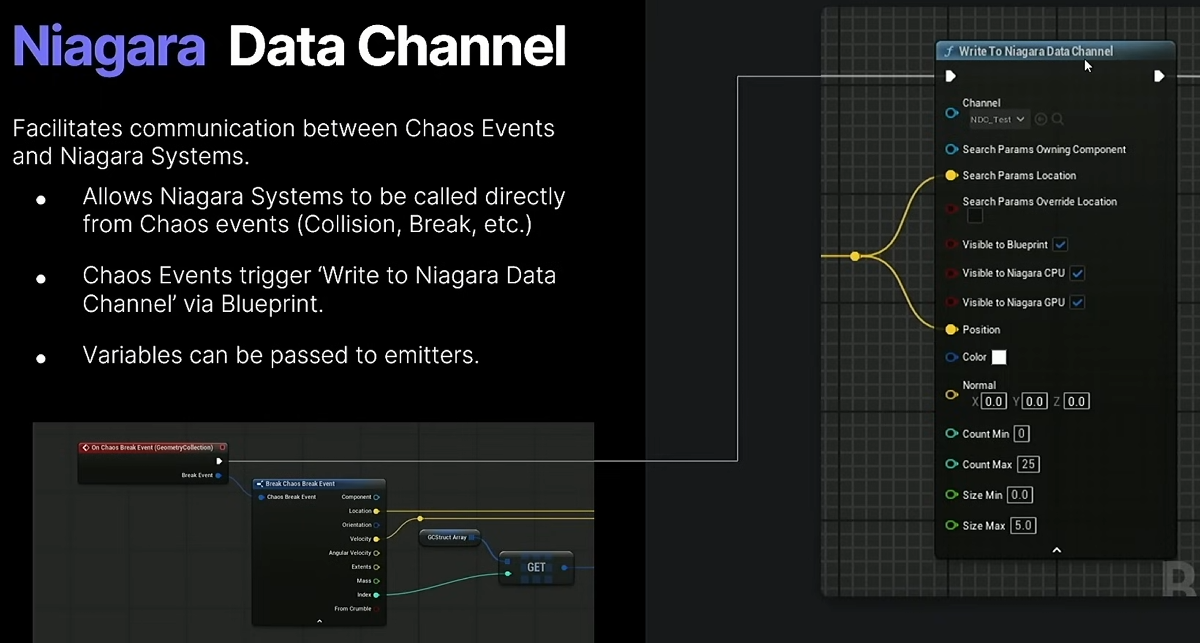For dataflow see Dataflow Graph.
Geometry Collection Component
About the physics
All particles (also called physic objects) exists once the physic state is created.
The proxy type is FGeometryCollectionPhysicsProxy.
The event dispatcher is UChaosGameplayEventDispatcher.
The GCC inherits IChaosNotifyHandlerInterface.
FGeometryCollectionItemIndex is used to get the index of the hit proxy body from a hit (See SetHitResultFromShapeAndFaceIndex).
Access to physics
- Get
FGeometryCollectionPhysicsProxywithGeometryCollectionComponent->GetPhysicsProxy() - Get Read/Write physics interface
Chaos::FReadPhysicsObjectInterface_Internal PhysicsObjectInterface = Chaos::FPhysicsObjectInternalInterface::GetRead();(watch out there is a internal and external version, use internal if you are on the physic thread) - Get
Chaos::FPhysicsObjectHandleof a particle withGCC->GetAllPhysicsObjects()
Collision
See CollisionProfilePerParticle and CollisionProfilePerLevel.
See UGeometryCollectionComponent::LoadCollisionProfiles.
Events
GCC events such as breaks and other collision events are handled by the EventDispatcher (UChaosGameplayEventDispatcher).
It is created in the GCC constructor so there is 1 event dispatcher actor instance per GCC.
More info at [[Physics types#uchaosgameplayeventdispatcher|UChaosGameplayEventDispatcher]]
Field Commands
For fields see Chaos Fields
Commands sent to UGeometryCollectionComponent::DispatchFieldCommand will end up in FGeometryCollectionPhysicsProxy::BufferFieldCommand_Internal inside a FFieldData.
Which is iterated inside FGeometryCollectionPhysicsProxy::FieldParameterUpdateCallback.
For example calling AddImpulse will result in FieldVectorParameterUpdate being eventually called.
Anchor
See SetAnchoredXXXX functions.
Change collision profile on broken parts/per particle
Use SetPerParticleCollisionProfileName. This will update CollisionProfilePerParticle which is read in UGeometryCollectionComponent::LoadCollisionProfiles.
Basic setup
void ABPGDestructibleBase::OnChaosBreakEvent(const FChaosBreakEvent& BreakEvent)
{
if (UGeometryCollectionComponent* GCC = Cast<UGeometryCollectionComponent>(BreakEvent.Component))
{
const int32 ParticleIndex = BreakEvent.Index;
// A member var of type TArray<int32> to store all broken parts over time
// SmallBrokenPartsCollisionProfile is of type FCollisionProfileName
SmallBrokenPartsBoneIds.Add(ParticleIndex);
GCC->SetPerParticleCollisionProfileName(SmallBrokenPartsBoneIds, SmallBrokenPartsCollisionProfile.Name);
}
}Get particle bounds
Do const FBox Box = PhysicsObjectInterface.GetBounds({PhysicsObject}); (there is also a GetWorldBounds version)
Example of code to run on tick to draw particle bounds with their volume
UGeometryCollectionComponent* GCC = Data.Key.Get();
TArray<Chaos::FPhysicsObject*> PhysicsObjects = GCC->GetAllPhysicsObjects();
for (auto& PhysicsObject : PhysicsObjects)
{
const FBox Box = PhysicsObjectInterface.GetWorldBounds({PhysicsObject});
const Chaos::FReal Volume = Box.GetVolume();
const bool bIsSmall = Volume <= 50000;
const FColor Color = bIsSmall ? FColor::Green : FColor::Red;
FU_Draw::DrawDebugBoxFrame(GetWorld(),
Box.GetCenter(), Box.GetExtent(), FRotator::ZeroRotator,
Color, 1, 1
);
FU_Draw::DrawDebugStringFrame(GetWorld(),
Box.GetCenter(), FU_Utilities::PrintCompactFloat(Volume), Color, 1
);
}From hit get particle
// not fully tested, WIP code
auto* Proxy = HitGCC->GetPhysicsProxy();
auto Item = VelocityHitResult.Item;
auto* ParticleAtIndex = Proxy->GetPhysicsObjectByIndex(Item);
auto* RealPart = ParticleAtIndex->GetParticle<Chaos::EThreadContext::External();
auto Loc = RealPart->GetX();
auto Rot = RealPart->GetR();
auto* RigidParticle = RealPart->CastToRigidParticle();
auto LinearVel = RigidParticle->GetV();
auto AngularVel = RigidParticle->GetW();Optimizing
Nanite
If your mesh has a lot of polygons try to enable Nanite.
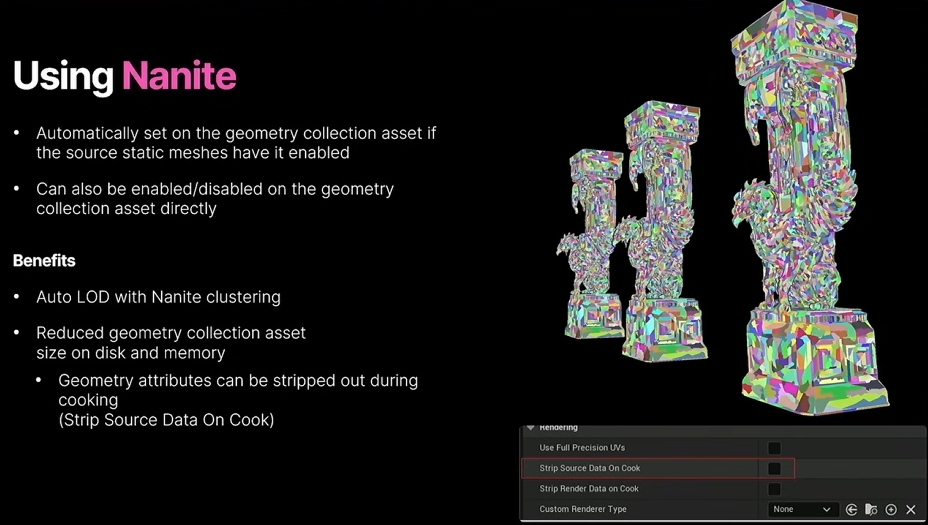
Root Mesh Proxies
You can replace your GC with one or multiple static meshes until the GCC breaks.
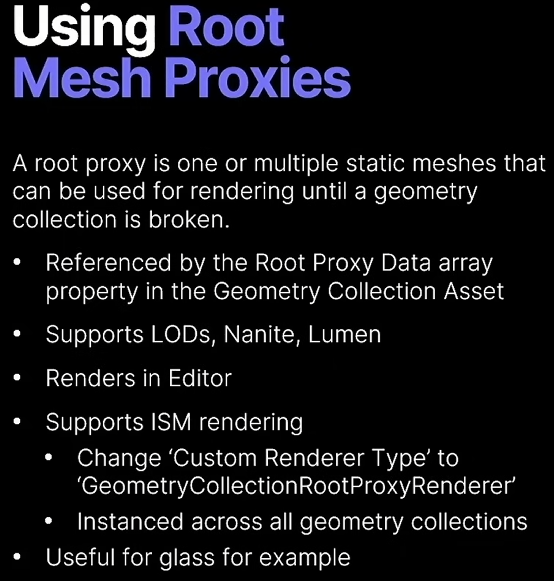
Remove On Break
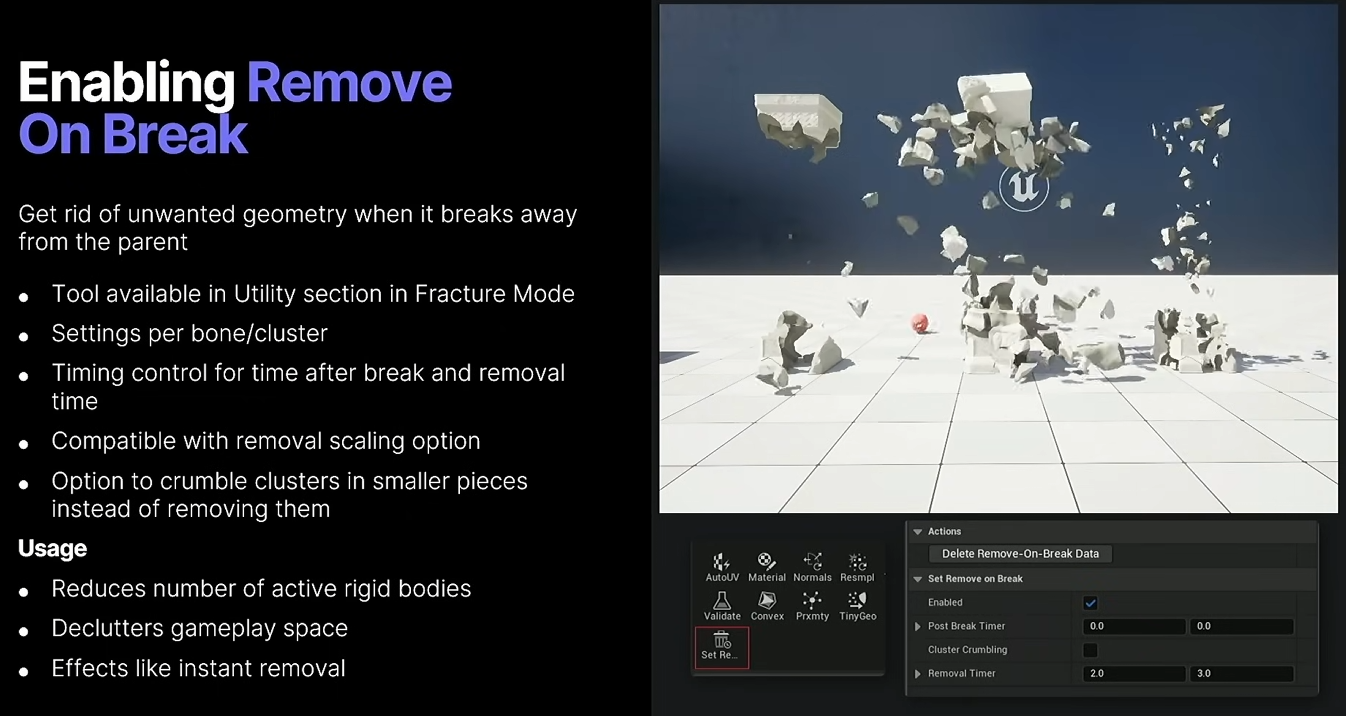
Remove On sleep
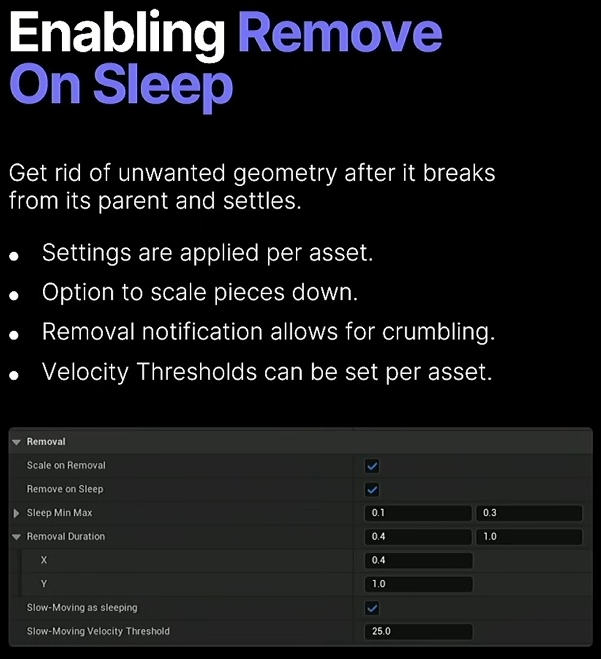
One way Interaction
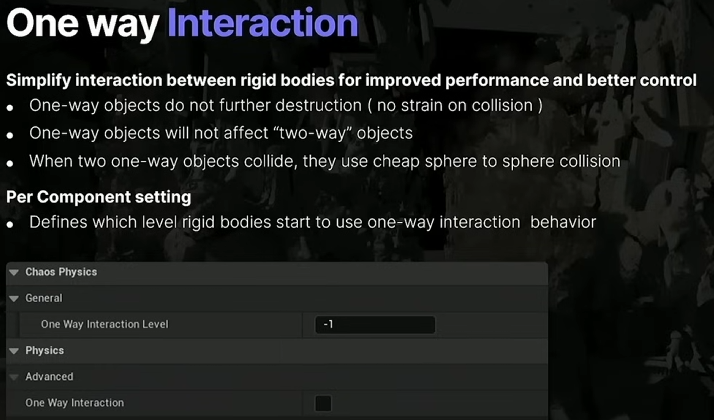
Throttling Mechanisms
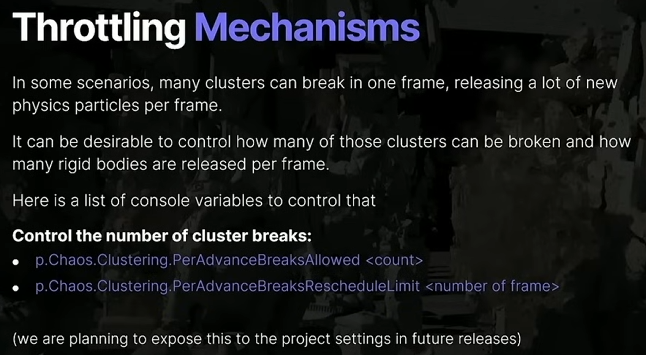
p.Chaos.Clustering.PerAdvanceBreaksAllowed <count>p.Chaos.Clustering.PerAdvanceBreaksRescheduleLimit <nb of frame>
Not using fields
Fields gives you a lot of control but has some overhead that can’t be ignored in some cases.
You can use instead Apply External Strain and Apply Breaking Linear Velocity/Apply Breaking Angular Velocity.
You can also use internal strain if you want to apply damage over time.
Miscs
Make it feel heavier
See this section of GDC 2025.
Cause destruction from collision

Niagara
Example in the content example project..
